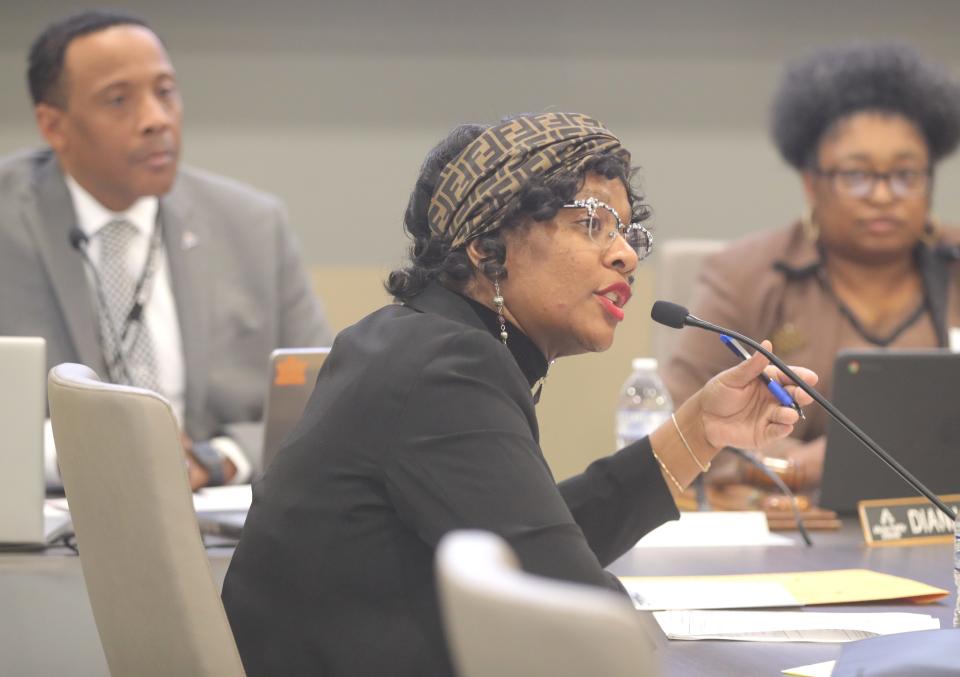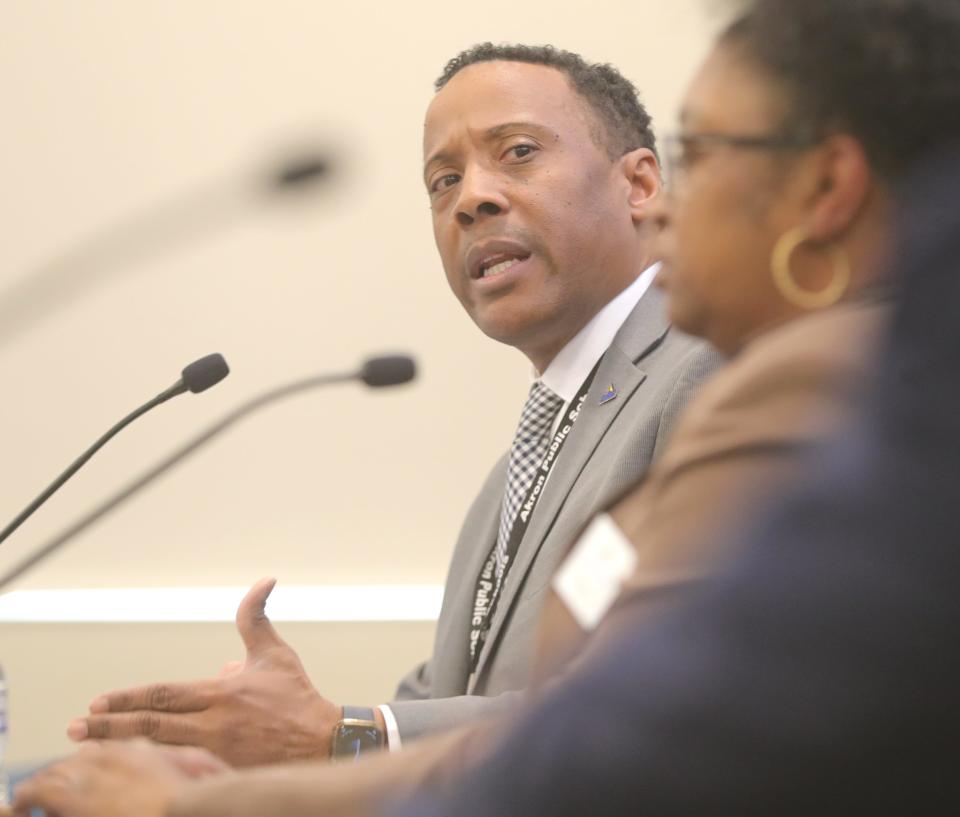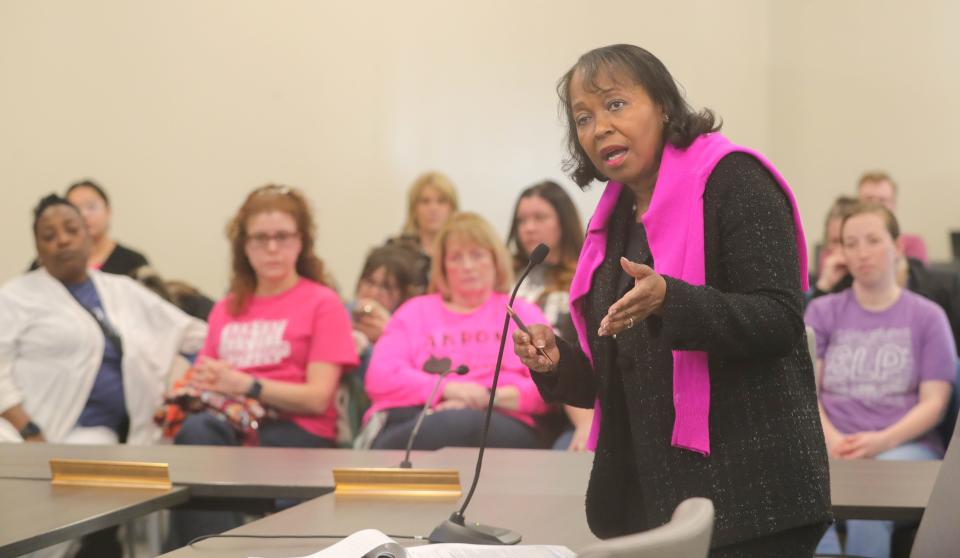Akron Public Schools board passes redistricting plan, rezoning thousands of students
The Akron Public Schools board approved a long-awaited redistricting plan in a special meeting Wednesday night, voting to close one building ahead of next school year and repurpose another.
The vote will rezone thousands of students into new schools, solving an overcrowding issue in elementary buildings in the North cluster and adjusting boundary lines to move with shifting enrollment.

Robinson Community Learning Center will close as an elementary school and become home to the STEM High School next year.
Firestone Park Elementary, one of the oldest buildings in the district that was not replaced with a CLC, will also close.
The board voted to keep Essex Early Learning Center open after voting last fall to close it, along with Stewart ELC, to accommodate an expanded pre-K program. Stewart will still close.
More: Akron Public Schools to offer full-day pre-K starting this fall, but what will it cost?
Firestone Park students will be rezoned to Glover, McEbright and Voris CLCs. Robinson students will be rezoned to David Hill and Mason community learning centers, keeping them within the East cluster of schools.
Essex will remain open, but Harris Jackson students who have been at Essex due to overcrowding at their home school will be returned to Harris Jackson.
Some Harris Jackson students will be rezoned to Barber CLC. Forest Hill CLC will also have some students rezoned to Harris Jackson, and a small number will be moved from Barber to Seiberling CLC.
To pass the vote, the board first voted Wednesday 5-1 to rewrite its policy on redistricting, removing requirements for public notice and public comment.
Only board member Rene Molenaur dissented, but several board members expressed frustration that the vote was necessary, and that the district's lawyer was not on hand to explain and defend the changes to them and the public.
"Every time we ask a question, we don't have an answer," Molenaur said.
The revisions to the policy included eliminating the requirement that the board "shall provide notice" to "the public" regarding proposed changes to boundary lines for schools, which determine students' building assignments each school year. That was changed to require the district to notify only parents of current students in the buildings that would be affected, not the general public or possible future parents and students of that school.
The revisions also removed a key time element in the notification process, which requires the public to have a 30-day notice ahead of the board's first, second and third readings of a resolution that would change a school's boundary lines.
There was concern, Board Vice President Carla Jackson explained, that the district had only done meetings at individual buildings and within clusters that were impacted by the changes and had not communicated the plan sufficiently to the rest of the district and public. The advice of counsel, she said, was to revise the policy in an "emergency" vote, which is permitted by the bylaws for circumstances of a threat to students' or employees' safety or welfare.
The "emergency," Jackson said, was that the board needed to give parents, teachers and administrators immediate clarity on where they attend school or teach next year.

Molenaur, who chairs the board's legal contracts and board policy committee, argued the issue was not an emergency that called for rewriting policy on a whim.
"This is an inconvenience of our own doing," she said. "Mismanagement of our own doing does not mean an emergency."
Superintendent Michael Robinson denied that the administration had done anything wrong. He noted several times that the policy was written before his arrival, although the redistricting process started after he became superintendent last year.

"There has been nothing wrong that has been done," he said. "It's just a policy from a couple years ago needs to be revisited."
Board member Barbara Sykes, the policy committee's co-chair, agreed there should have been another option beyond rewriting the policy at the last minute, but she said she would commit to revising the policy again in committee.
"What else can we do but vote for this?" she said.

Three members of the public also spoke, including Rev. Greg Harrison, who pushed for the board not to strip the requirements for public comment out of a policy.
"You're saying on one hand, you want public engagement, while on the other hand, you're saying we're going to take it away," he said.
Harrison said he understood the urgency and that the vote "probably should have happened sooner."
"But because it didn't does not mean that you get rid of a rule," he said.
Fran Wilson, a community organizer, also raised the same concern.
"Please consider more public engagement and making more access for public comment and engagement, not less," Wilson said.
After the 5-1 vote on the policy change, the vote to approve the redistricting plan was 6-0. Board member Bruce Alexander was absent.
The board and the superintendent also had an extensive discussion about Essex, with a row of Essex teachers sitting in the front row. There was contention over whether the administration could tell the teachers if their building would be used at all if the board reopened it, and when they would know. The deadline for teachers to request a transfer is April 1.
Molenaur pressed the superintendent about when they would make a decision about whether Essex would be used. Robinson initially said it would depend on pre-K enrollment, which they are hoping increases next year with a move to offer full-day classes. The administration later agreed to promise teachers they could stay at the school if they wanted if the board voted to keep the school open, which they did.
The board also voted to rename STEM High School the National Inventors Hall of Fame (NIHF) STEM High School at Robinson CLC. It is the first of the 30-plus community learning centers built over the last two decades to be completely repurposed. The school will continue to house a Family Resource Center, a partnership with United Way, to serve the entire East cluster.
Contact education reporter Jennifer Pignolet at jpignolet@thebeaconjournal.com, at 330-996-3216 on Twitter @JenPignolet.
This article originally appeared on Akron Beacon Journal: Akron Public Schools board passes redistricting plan, policy change

